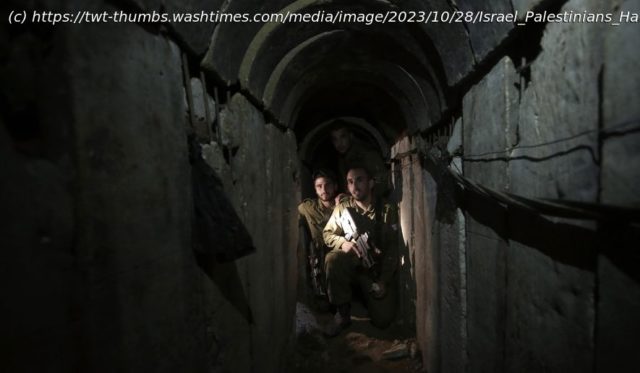As an Israeli ground offensive in the Gaza Strip looms in its most devastating war yet with Hamas, one of the greatest threats to both its troops and the 2.3 million Palestinians trapped inside the seaside enclave is buried deep underground.
As an Israeli ground offensive in the Gaza Strip looms in its most devastating war yet with Hamas, one of the greatest threats to both its troops and the 2.3 million Palestinians trapped inside the seaside enclave is buried deep underground.
An extensive labyrinth of tunnels built by the Hamas militant group stretches across the densely populated strip, hiding fighters, their rocket arsenal and over 200 hostages they now hold after an unprecedented Oct. 7 attack on Israel.
Clearing and collapsing those tunnels will be crucial if Israel seeks to dismantle Hamas. But fighting in densely populated urban areas and moving underground could strip the Israeli military of some of its technological advantages while giving an edge to Hamas both above and below ground.
“I usually say it’s like walking down the street waiting to get punched in the face,” said John Spencer, a retired U.S. Army major and the chair of Urban Warfare Studies at the Modern War Institute at West Point.
Urban defenders, he added, “had time to think about where they are going to be and there’s millions of hidden locations they can be in. They get to choose the time of the engagement – you can’t see them but they can see you.”
Overnight on Saturday, the Israeli military said its warplanes struck 150 underground Hamas targets in northern Gaza, describing them as tunnels, combat spaces and other underground infrastructure. The strikes – what appeared to be Israel’s most significant bombardment of tunnels yet – came as it ramped up its ground operations in Gaza.
Tunnel warfare has been a feature of history, from the Roman siege of the ancient Greek city of Ambracia to Ukrainian fighters holding off Russian forces in 24 kilometers (15 miles) of Soviet-era tunnels beneath Mariupol’s Azovstal Iron and Steel Works for some 80 days in 2022.
The reason is simple: tunnel battles are considered some of the most difficult for armies to fight. A determined enemy in a tunnel or cave system can pick where the fight will start – and often determine how it will end – given the abundant opportunities for ambush.
That’s especially true in the Gaza Strip, home to Hamas’ tunnel system that Israel has named the “Metro.”
When Israel and Egypt imposed a punishing blockade on Gaza after Hamas seized control of the territory in 2007, the militant group expanded construction of its tunnel network to smuggle in weapons and other contraband from Egypt. While Egypt later shut down most of those cross-border tunnels, Hamas is now believed to have a massive underground network stretching throughout Gaza, allowing it to transport weapons, supplies and fighters out of the sight of Israeli drones.






